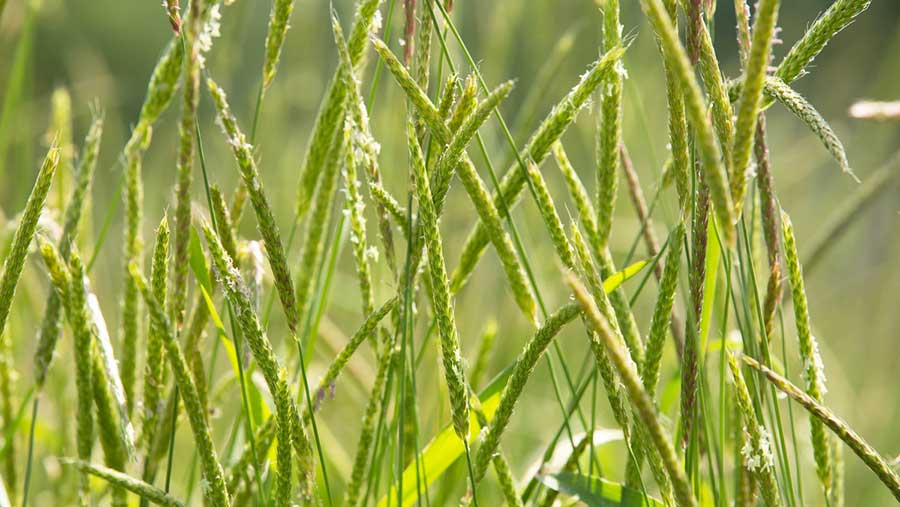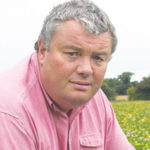Hit high blackgrass seed return with ‘every weapon’
Grassweed, foliar disease and pest problems are discussed by our four agronomists this week
Poor crop competition and post-emergence herbicide performance this spring has led to high blackgrass seed return and Agrii adviser Iain Richards advocates using all tools available this autumn to avoid huge problems in 2017.

© Tim Scrivener
In the West, Stephen Harrison is also seeing plenty of brome in winter barley and again, seed return likely to be high. With no post-emergence herbicide options, he advises against planting a second winter barley crop.
Tip of the week
When planning your rotation, think diversity and flexibility.” Patrick Stephenson, AICC
On the foliar disease front, Mr Harrison is concerned about eyespot in maize due to wet weather and a fungicide could be required this year.
Yorkshire-based Patrick Stephenson warns about the continuing threat of chocolate spot in winter beans, which should be closely monitored.
Pests continue to proliferate and in Suffolk, Marion Self is keeping an eye on aphid colonies in wheat and pulse crops and also bruchid beetle in spring beans.
North
Patrick Stephenson, AICC (Yorkshire)

I have been travelling down to Cereals in Cambridgeshire for many years and I have watched the tide of blackgrass surge up the country.
I can now leave Pickering and see the weed all the way to the site. Add to this the bromes and poppies everywhere and there is not a lot to smile about.
With the exception of yellow rust, it has been a relatively low disease year. It has to be said though that yellow rust has been exciting and Niab’s Bill Clark has a twinkle in his eye when talking about teliospores and dynamic populations.
To cut a three-hour dialogue into concise words: “do not assume any variety will retain its rust resistance rating”. As for septoria ratings, these appears to be a more stable.
Winter beans look well, but chocolate spot is bubbling away and will need close monitoring. Oats similarly have enjoyed the year and look well.
It is hard to believe, but I still have oilseed rape crops flowering and with the swarms of diamond back moth in the air, vigilance is still required.
This season was late in starting and it is certainly going to be late finishing. This will have some significant effect on cropping and rotations.
South
Iain Richards, Agrii (Hampshire/Wiltshire)

The extent to which delaying wheat drilling for blackgrass control has helped us manage septoria provides another excellent reason for patience.
Not that many need any extra incentive with the horrendous blackgrass levels currently being experienced.
This has been disappointing, as we went into the winter with weed populations of just 5-6 plants/sq m in many cases after good pre-emergence herbicide activity.
Poor competition from crops in the cold March as blackgrass profited from their nitrogen, however, meant plants tillered freely to produce 20 or more heads. Unsurprisingly, spring herbicides couldn’t touch them.
Thankfully, late development means we’re unlikely to see much yield reduction, but we’ll have a massive seed return to deal with. So we’ll have to bring every weapon to bear to avoid huge problems in 2017.
We should not be thinking of sowing wheat into bad blackgrass fields before the middle of October.
We’ll need to focus on varieties that can be sown later or in the spring for flexibility.
We’ll need to make our first cultivation the deepest, then leave the ground for 6-7 weeks wherever possible and disturb as little soil as possible at drilling.
We’ll need to think hard about seed-bed nutrition. Finally, we’ll need to prioritise first class weed control in our break crops – especially winter oilseed rape.
East
Marion Self, Prime Agriculture (Suffolk)

Crops look relatively well, with more yield potential than I would have anticipated in early spring.
And at last it feels as though we are on the home run as we complete treatments on many crops, harvest preparation is underway and autumn strategies are being planned.
In both wheat and pulses keep an eye on aphid colonies that could build quickly if temperatures warm. In peas, also check crops for pea moth and pea midge.
Remember the new pirimicarb (for example, Aphox) rules; new label products can only be applied once, with a maximum dose of 280g ai/ha. Pyrethroids only offer partial aphid control; in peas only thiacloprid (for example, Biscaya) is another option, although more expensive.
Continue to monitor spring beans for bruchid beetle, the trigger for control at pod set is when temperatures reach 20C on two consecutive days.
This is a good time to evaluate the season and plan for the next crops including autumn herbicide strategies and remedial soil cultivations. It’s helpful to map weed or soil problems.
Many of you will be visiting variety demonstrations during the next month and selecting wheat varieties for sowing this autumn.
Choose varieties with attributes that closely match your specific requirements. Many of the newer Recommended List varieties have improved septoria resistance, with scores of 6 and above.
West
Stephen Harrison, AICC (Avon)

The end of the spraying season is in sight as far as combinable crops go. Remaining tasks will be desiccation of crops such as winter oilseed rape and spring linseed.
One exception will be the maize crop where the wet weather means a fungicide for maize eyespot is increasingly likely.
This disease can decimate crops if left unchecked, ignore it at your peril.
Aside from the ever-present difficult blackgrass issues, the grassweed causing the biggest headache is brome in winter barley – particularly soft, meadow and rye brome.
Soft brome can hybridise with other species, making identification tricky.
It appears to germinate in early spring, long after pre-emergence residual herbicides have run out of steam and there are no post-emergence options in barley.
If you have brome in your winter barley, seed return will be high. I urge you not to grow a second winter barley in these circumstances.
Rotational planning for next year is well underway and the watch word is resilience, both in varietal choice and crop type selection.
In particular, we will be focusing on light leaf spot resistance in winter rape. I suspect demand will be high for the best varieties, so start planning now.
I am now looking forward to visiting local independent trials to analyse where any changes could be made during the next growing season. Cereals may have the razzmatazz, but locally is where I learn the most.

